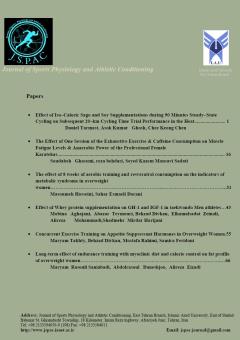-
-
List of Articles
-
Open Access Article
1 - Effect of Iso–Caloric Sago and Soy Supplementations during 90 Minutes Steady–State Cycling on Subsequent 20–km Cycling Time Trial Performance in the Heat
Daniel Tarmast Asok Kumar Ghosh Chee Keong Chen -
Open Access Article
2 - The Effect of One Session of the Exhaustive Exercise & Caffeine Consumption on Muscle Fatigue Levels & Anaerobic Power of the Professional Female Karatekas
Reza behdari Soudabeh Ghasemi Seyed Kazem Mousavi Sadati -
Open Access Article
3 - The effect of 8 weeks of aerobic training and resveratrol consumption on the indicators of metabolic syndrome in overweight women
Masoumeh Hosseini Sahar Esmaeli Dorani -
Open Access Article
4 - Effect of Whey protein supplementation on GH-1 and IGF-1 in taekwondo Men athletes
Mobina Aghajani Abazar Teymouri Elhamalsadat Zeinali Alireza Mohammadi Shadmehr Mirdar Harijani -
Open Access Article
5 - Concurrent Exercise Training on Appetite Suppressant Hormones in Overweight Women
Maryam Takhty Asal Ziloubaf Samira Feridoni Sadra Sheidaei Mostafa Rahimi -
Open Access Article
6 - Long-term effect of endurance training with myoclinic diet and calorie control on fat profile of overweight women
Maryam Rasouli Saniabadi Abdolrasoul Daneshjoo Alireza Eizadi
-
The rights to this website are owned by the Raimag Press Management System.
Copyright © 2017-2026







